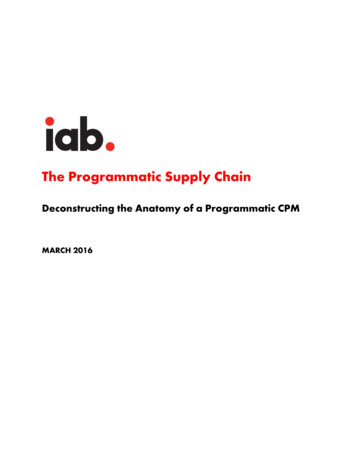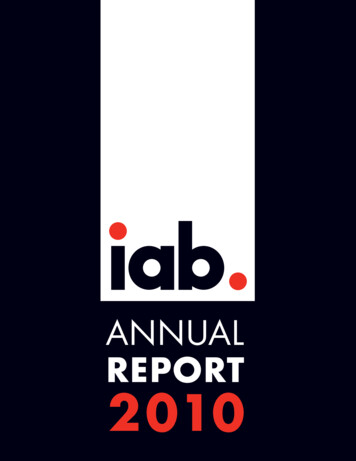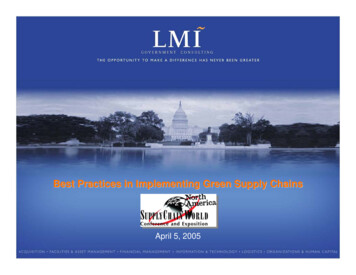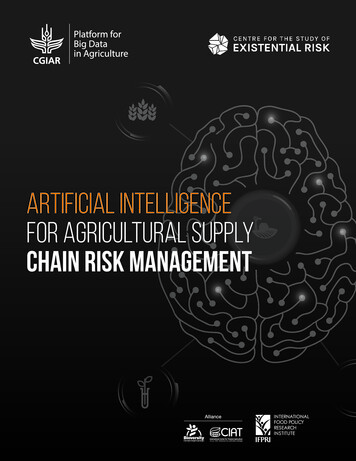
Transcription
The Programmatic Supply ChainDeconstructing the Anatomy of a Programmatic CPMMARCH 2016
This document has been developed by the IAB Programmatic Fee TransparencyWorking Group.About the IAB Programmatic Fee Transparency Working GroupThe IAB Programmatic Fee Transparency Working Group is a group of IAB members who worked together tohelp shed light on the complexity of the many players and technologies in the programmatic ecosystem. TheWorking Group strives to reinforce the trust and liquidity in the marketplace.IAB Programmatic Fee Transparency Working Group RosterAccuenIDG TechNetworkThe Exchange LabAdFinIntegral Ad ScienceThe Trade DeskAdGear Technologies, Inc.LiveRailThe Weather CompanyAlliance for Audited Media)News CorporationTime Inc.C1 ExchangePandoraTremor VideoCadreonProhaska ConsultingTrustworthy Accountability GroupCBS InteractivePubMaticTubeMogulCox Media GroupRADS MediaTurn Inc.DailyMail.com/Elite DailyRocket FuelUndertoneDemand MediaRubicon ProjectViacomGawker MediaSizmekVideoplazaGoogleSQADXaxisHorizon MediaTavant TechnologiesYahooHuluTerra Networks USAAbout IABThe Interactive Advertising Bureau (IAB) empowers the media and marketing industries to thrive in the digitaleconomy. It is comprised of more than 650 leading media and technology companies that are responsible forselling, delivering, and optimizing digital advertising or marketing campaigns. Together, they account for 86percent of online advertising in the United States. Working with its member companies, IAB develops technicalstandards and best practices and fields critical research on interactive advertising, while also educating brands,agencies, and the wider business community on the importance of digital marketing. The organization iscommitted to professional development and elevating the knowledge, skills, expertise, and diversity of theworkforce across the industry. Through the work of its public policy office in Washington, D.C., IAB advocatesfor its members and promotes the value of the interactive advertising industry to legislators and policymakers.Founded in 1996, IAB is headquartered in New York City and has a West Coast office in San Francisco.IAB Contact InformationBenjamin DickDirector, Industry InitiativesProgrammatic Data Performanceben@iab.comThe Programmatic Supply Chain 1
Table of ContentsOverview . 2Participants in the Supply Chain . 2Overview of Primary Programmatic Value Layers . 3The Spectrum of Buy-side Managed Service Options . 4Mapping Value Layers within RTB Ad Calls. 5Latency and Security Considerations. 5Ad Technology vs. Publisher Revenues . 6Programmatic Fee Transparency Calculator . 6References . 7The Programmatic Supply Chain 1
OverviewThe diversity of programmatic ad technology services – as well their associated implementation options andcost models - has exploded over the past several years as the industry responds to changing marketplacedynamics. While these third party tools have provided an unprecedented level of control and efficacy forpractitioners, the increasing complexity in the programmatic value chain has also created some unforeseenconsequences.First, given the number of ad tech services commonly applied to programmatic buys, it has become difficult foradvertisers and marketers to keep track of a) what specific service types are being used, and b) their relativevalue compared to other components of the buy. Second, there is a lack of communication between buyers andsellers about the ad technologies being used by each side as well as the fees that are removed in the bidding1process before publishers’ net CPMs are realized. This creates a discrepancy between buy and sell sideinventory valuations, which has the potential to erode trust in the marketplace and reduce inventory and priceliquidity. The first step in improving transparency is to deconstruct the individual components of these adtechnology layers and their value propositions.Participants in the Supply ChainThere are several factors that have contributed to the complexity of the programmatic supply chain as themarketplace has matured. The types of participants can be categorized based on the technologies or servicesthat they provide: Core Ad Technology (Costs of Doing Business): There are several core technology servicesthat are standard costs of doing business. They can be thought of as foundational technologies that arenecessary to transact programmatically. Primary examples include ad serving, demand side platforms,and sell side platforms. Management Services: Management services have been developed to address buy or sell sidetechnology and proficiency gaps. They often include access to programmatic resources, proprietarytools, and specialist campaign managers. Management services are most often used by advertisers orpublishers who prefer to outsource programmatic activity or don’t have the resources to build internalcapabilities. Audience Addressability Needs: The ability of programmatic tools to evaluate and makedecisions on individual impressions based on audience and/or optimization goals, has facilitatedrddozens of specialist services that provide audience targeting or segmentation. Examples include 3party data providers and Data Management Platforms (DMPs). Inventory Verification: Inventory quality concerns - specifically as it relates to brand safety,viewability, and fraud - has created a need to verify inventory delivery. Recent accreditation ofverification tools by industry bodies has facilitated adoption by practitioners, and allowed advertisersand publishers to report and transact on verified impressions instead of overall impression delivery.The Programmatic Supply Chain 2
Overview of Primary Programmatic Value LayersWhile it would be self-defeating to identify and define every type of programmatic service in a constantlyevolving landscape, the table below describes the most common programmatic ad technologies and serviceswithin the supply chain, frequently used cost models, and the party (buy vs. sell) that generally applies theservice:SERVICECOSTMODELVALUEPAYERAD BLOCKING(PRE/POST)Technology that allows advertisers to block ad delivery based on a set ofinventory quality signals, which could include viewability, brand safety, andCPMfraud. Can be blocked on either a pre-bid or a post-bid basis afterinventory is won.AdvertiserADVERTISER ADSERVINGTechnology that provides centralized storage, tracking, and delivery ofmedia campaign assetsAdvertiserMANAGEMENTSERVICE*Service for setting up, managing, and optimizing programmatic delivery, aswell as building / maintaining buy or sell side infrastructure (inventory,FTE, % Media Advertisertechnology, data, reporting relationships). There are many different types ofmanaged service offerings, as outlined below.DATA / TARGETING3rd party data segments used for identifying and targeting specific types of CPM, %users or devices. Generally speaking, 1st party segments (data collectedMediaand applied by user) are not paid for.DATA MANAGEMENT Technology service that allows operators to aggregate and normalizedisparate data sets for advanced campaign analytics/reporting.PLATFORM (DMP)CPMAdvertiser,PublisherCPM, Flat FeeAdvertiser,PublisherCPM, %MediaAdvertiserDEMAND-SIDEPLATFORM (DSP)Software used to access and decision against publisher inventory. Otherfunctions usually include bundled bidding algorithms / optimizationtechniques, 3rd and 1st party data integrations, tagging and attributionfunctionality, and media delivery reporting.PRE-BIDDECISIONING /TARGETINGTools that allow advertisers to evaluate the quality of individual publisherimpressions and influence decisioning before bidding. Quality is evaluatedCPMlargely against viewability, brand safety and/or fraud, and is often coupledwith ad blocking functionality (see above).AdvertiserPUBLISHER ADSERVINGSoftware to manage advertiser creative tags and delivery priority amongstCPMmany advertisers.PublisherSELL-SIDE PLATFORM Software used by publishers to aggregate, consolidate, and manageavailable demand sources and exchange inventory. Sometimes includes ad % Media(SSP)serving functionality.VERIFICATION3rd party technology intended to measure on target delivery, viewability,brand safety, or fraud. Often but not necessarily the same provider of pre- CPMbid and post-bid tools.PublisherAdvertiser,Publisher*See additional detail on Managed Service models in the next sectionThe Programmatic Supply Chain 3
The Spectrum of Buy-side Managed Service OptionsDue to advertisers’ varying degrees of fluency with programmatic buying tools and concepts, there’s been astratification of managed service options that vary significantly in terms of service and fee levels. As such, themodel an advertiser uses can significantly impact the executional costs of programmatic activity and requiresadditional clarification beyond the overview above.Managed service models tend to be differentiated primarily based on level of advertiser oversight requestedand the amount of upfront resource commitments to technology and human capital, however there tend to be asignificant number of negotiable service options. Advertisers need to determine the most appropriate approachafter careful examination with agency and technology partners. Below is a description of the five most commongo-to-market models, beginning first with the most intensive service levels and ending with the least.Holding Company Oversight: Shared Trading and Data Storage - Advertiser shares programmatictechnology and human resources with other advertisers within a larger agency or holding company. P r o s : Due to specialized nature, this model tends to offer bespoke technology and data visualizationsolutions, minimizes upfront programmatic investments in human capital, and leverages collectivebuying power for forward market data and inventory cost reductions Cons: Minimal advertiser involvement in daily operations, often non-disclosed fee models, somerestrictions on inventory and targeting pending forward market commitments, limited advertiser controlover technology stack unless specifiedAgency Oversight: Managed-service DSP – Advertiser’s media agency manages portfolio of DSPoperated programmatic services. P r o s : No need for investment in programmatic resources, no barriers to entry, media managed andoptimized by trained personnel inside DSP, fees usually disclosed by DSPs Cons: Many DSP partners have interests in supply partners and are thus not media agnostic, limitedadvertiser oversight of daily operations, limited control over technology stack or inventoryAgency Oversight: Hybrid Managed Service / Self-service Desk – Advertiser’s media agencyuses a combination of managed service programmatic offerings and self-service trading (see below).Agency Oversight: Self-service Dedicated Desk – Advertiser’s media agency houses dedicatedagency personnel that manage advertiser programmatic campaigns and usually builds custom technology/data/inventory relationships. P r o s : Holistic view cross media investments, full cost and inventory transparency, allows for consistentoptimization and cross channel reporting, dedicated resources, can leverage agency scale fortechnology and inventory negotiations, client dedicated in-house expertise Co n s : High upfront costs for agency to train talent, develop inventory relationships, and developinternal processes and workflowThe Programmatic Supply Chain 4
Advertiser Oversight: In-house Desk - Advertiser sources personnel, training, and technologydevelopment inside organization instead of a media agency. P r o s : Complete control over how communications objective gets translated into media investment,centralized oversight of proprietary data, full autonomy to select technology partners Co n s : Requires heavy financial and resource commitment, takes time to develop / train staff and buildprocesses, reduces negotiation leverage on inventory, data, technology feesMapping Value Layers within RTB Ad CallsIt’s often helpful to visually place these services within the anatomy of a bid request / response to understandwhen each service is engaged. Where a value layer sits within this sequence – specifically pre or post bid could also determine whether a fee is charged upon ad delivery.While the actual ad call sequences are bi-directional and much more complex than depicted here, the belowdiagram provides a directional outline of where each service identified above sits within a standard auctionbased (vs. fixed price) programmatic transaction.Latency and Security ConsiderationsAlmost all technologies applied to programmatic executions add additional communication requirements for auser’s browser. These requirements can increase page load times and pose data security problems that have thepotential to detract from overall user experience and efficacy of paid media. Advertisers and publisher shouldwork with their technology partners to thoroughly review latency and security implications of their services.Page Latency - Ghostery estimates that, on average, each additional technology layer (and associated2tracking pixels) adds 500ms to a user’s page load time . As advertisers and publishers evaluate adtechnology solutions, especially those beyond core technologies, they should weigh the value of the servicerelative to its impact on the ultimate user experience with the web content.The Programmatic Supply Chain 5
Security – publisher pages increasingly require secure http browsing, which prevents third parties fromeavesdropping on the information being sent between a user and publisher via http. If the ad technologyapplied to an ad creative has tracking that’s not secure, the user’s browser can prompt consumers with what’sknown as a mixed content security warning, which often dissuades users from loading the webpage containingthe advertisers content. Additionally, on the publisher side, SEO and SEM rankings can suffer if high levels ofnon-secure content are allowed on secure pages. As such, both buyers and sellers should have checks in placeto ensure that the ad technology tracking applied to programmatic buys is SSL compliant.Ad Technology vs. Publisher RevenuesWhile ad technology fees incurred by buyers and sellers vary greatlydepending on which services are applied and the levels of managedservices being requested, they cumulatively represent a significant portionof programmatic revenues. The IAB estimates that, in 2014, adtechnology services cumulatively captured 55% of programmatic revenue3while publishers captured the remaining 45% .While these fees are an inevitable and important part of the ecosystemthat support the platforms that enable programmatic transactions, it’sclear that buyers and sellers need to have better tools to help themevaluate the overall costs of programmatic technologies and servicesrelative to the benefits they provide.Programmatic Fee Transparency CalculatorThis document is intended to outline the value and cost structures of key ad tech components, provide contextfor their use, and arms practitioners with the information they need to effectively manage their portfolio oftechnology vendors and publisher relationships.For those who want to go one step further, the IAB has developed a Programmatic Fee Transparency Calculatorthat can be found on the IAB website at iab.com/calculator. The calculator is intended to provide advertisersand publishers more granular, campaign specific cost breakouts based on their particular implementations. Thetool tabulates the overall cost of each actor in the supply chain (as a percentage of the effective CPM) after theuser enters his/her channel specific planning rates, budgets, and ad technologies/services.We hope this document and corresponding tool helps arm practitioners with a keen understanding of thecomponents that make up their programmatic activity and helps effectively manage and maximize its value.The Programmatic Supply Chain 6
References1. This paper focuses on programmatic technology services only. For more information on feetransparency, see “Transparency is the Key to Programmatic 2. Ghostery, Inc. Interview with Ghostery CEO Scott Meyer. IAB Annual Leadership Conference. January26, 2016.3. IAB Programmatic Revenue Report 2014 Results. July 2015. Full report can be found here:http://www.iab.net/media/file/PwC IAB Programmatic Study.pdfThe Programmatic Supply Chain 7
workforce across the industry. Through the work of its public policy office in Washington, D.C., IAB advocates for its members and promotes the value of the interactive advertising industry to legislators and policymakers. Founded in 1996, IAB is headquartered in New York City and has a West Coast office in San Francisco.










